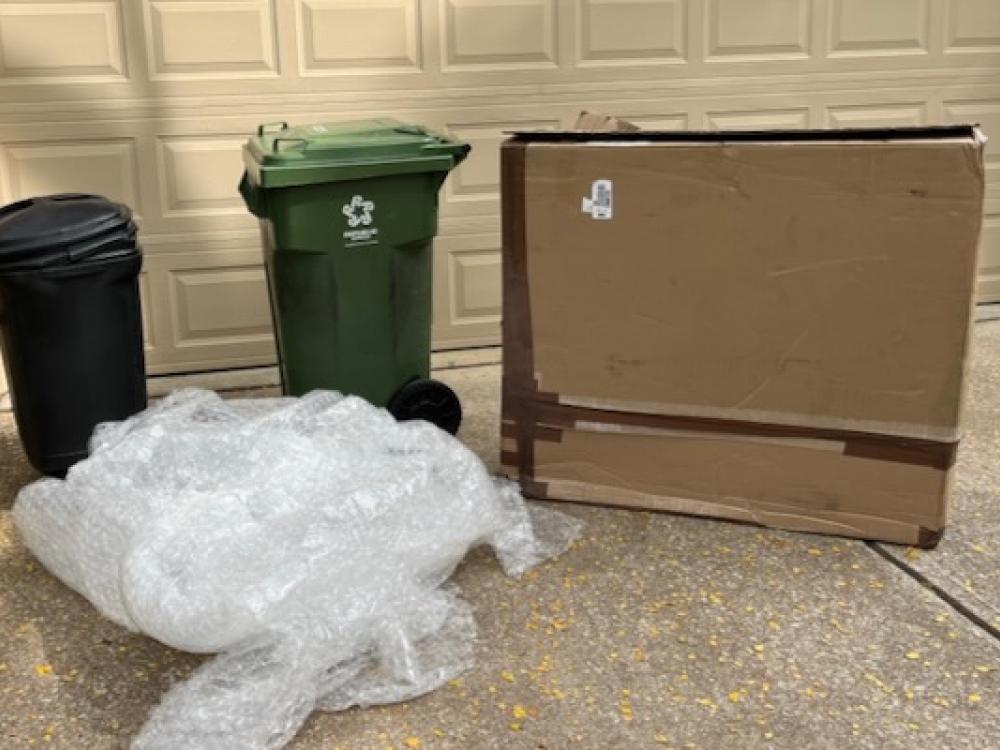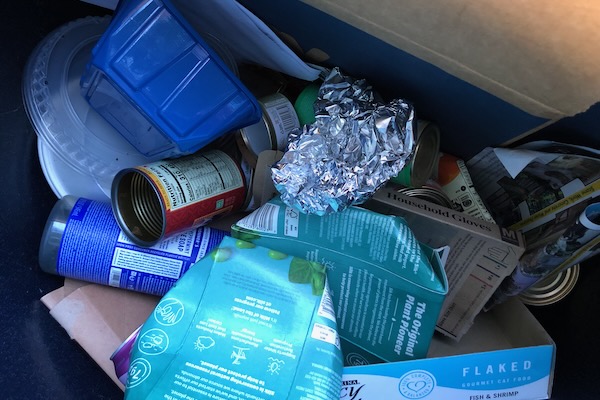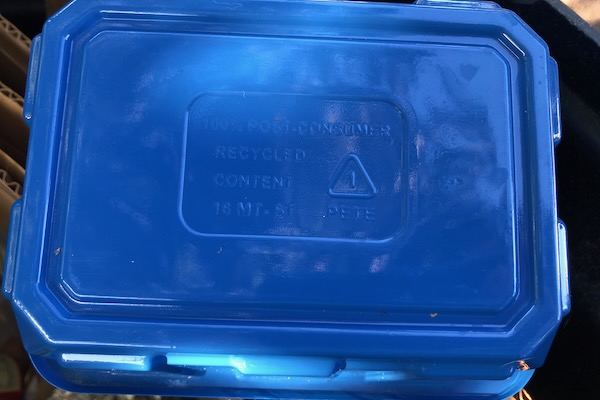
Bubble wrap is one of the items that should not go into a curbside recycling bin. However, cardboard is desired by local municipal recycling facilities in DFW. Photo by Harriet Blake.
Oct. 11, 2023
We recently inherited a painting from my late in-laws. It arrived wrapped in multiple layers of bubble wrap inside a 4-foot-by-6-foot box. We knew what to do with the cardboard, but what about the bubble wrap?
Fortunately, we discovered that bubble wrap can be recycled along with plastic bags at some grocery store collection bins. Also some mail centers will take it. But I learned it should never be put in curbside recycling bins.
“Bubble wrap is considered flexible plastic and [if sent to recycling], it can get wrapped and tangled around the machine shaft requiring us to disassemble and repair,” said Jeremy Walters, manager of external communication for Republic Services. "In terms of curbside recycling, they are trash."
So, please, do not recycle bubble wrap in your recycling bin, he says.
That led us to wonder — so what should be recycled in our recycling bins and what exactly happens when your recycling leaves your curb? Most of us in the DFW area trust that it goes to the proper channels and gets recycled and re-used. But does it?
MATERIALS RECYCLING FACILITIES
Republic Services operates in about 125 North Texas municipalities, including much of Tarrant County. Nearly 30 cities feed into their 77,000-square-foot municipal recycling facility in Plano, which opened in 2019 as one the most technologically advanced in the area.
Meanwhile, residential recycling from 25 cities is trucked to Republic’s 90,000-square-foot MRF in Fort Worth, which opened in 2013.
“Compared to the Fort Worth facility, the Plano MRF is smaller but it utilizes some newer equipment that improves the efficiency and efficacy of processing recyclables,” says Walters, who is also known as Republic’s “sustainability ambassador.
The Plano facility also has an interactive learning center where the public can schedule tours to learn about the recycling process, he says.
In Dallas, the FCC Materials Recovery Facility covers much of Dallas County as well as Garland, Rowlett and Mesquite. FCC opened its state-of-the-art MRF at the McCommas Bluff Landfill in 2017.
Bruce Magnuson is the senior general manager with FCC and he notes that while FCC opened in the United States in 2015, the company originated in the early 1900s in Spain.
SORTING IT OUT
 In most cities in DFW, residents can co-mingle a mix of recyclables in recycling bins. Photo by Julie Thibodeaux.
In most cities in DFW, residents can co-mingle a mix of recyclables in recycling bins. Photo by Julie Thibodeaux.
In most area cities, customers can co-mingle their recyclables; a few still require separating paper and plastic.
At Republic Services, once the recycling bin leaves the curb, Walters says the material from the truck is dumped onto the top floor of their recycling facility. Here, loaders scoop up the material and drop it into metering bins. From there the material heads to the presort deck where employees sort out obvious non-recyclable items such as patio furniture and sometimes even bowling bowls. The metered bins influence the volume at which the material is fed into the system.
The items are then sorted by size and by type of material: paper, plastic, metal and glass.
The paper goes through a series of disc screens that separate it and then the material goes past human eyes. The quality control of having technology and real people do the sorting ensures items get to the right place.
“The paper bundles must be 99.95 percent pure paper,” says Walters.
Once paper is sorted, then the facility separates plastic, metal and glass. Metal is sorted with magnets to remove steel cans (such as soup cans). For aluminum, the facility uses an “eddy current,” which pulls out the aluminum items electro magnetically, using a reverse polarized magnet. Glass gets broken down into small pieces and goes to a glass bunker.
After paper, metal and glass are separated, the only material left is plastic. Walters says there are several categories of plastic and they must be separated as well.
 The number marked on plastics is the resin identification code, which identifies the type of plastic resin the item was made from. Photo by Julie Thibodeaux.
The number marked on plastics is the resin identification code, which identifies the type of plastic resin the item was made from. Photo by Julie Thibodeaux.
Clear water bottles (PET) are number one plastics. Solid-colored and opaque plastic containers (HDPE) such as milk and laundry jugs and shampoo bottles are number two. Polypropylene containers such as yogurt are number five.
A computerized optical sorter shines light onto the material with near infrared imaging. Depending on what is reflected back up determines whether plastic should be sorted or not.
What’s left after the process, is trash, says Walters.
“It gets loaded up and sent to the landfill.”
A video shows the sorting process at the FCC Materials Recycling Facility at the McCommas Bluff Landfill in Dallas. Courtesy of City of Dallas.
Similarly, FCC’s Magnuson says that after the recyclables are collected, the materials are brought to their plant, located at the McCommas Bluff Landfill site in southern Dallas.
Here, they have a high tech state-of-the-art equipment that sorts cardboard, glass, mixed paper, plastics including plastic water and soda bottles (PET, polyethylene terephthalate) and milk and laundry detergent jugs (HDPE, high-density polyethylene) and margarine tubs (polypropylene), as well as steel and aluminum. Their recycling machines process over 30 tons per hour, says Magnuson.
“If we didn’t run that fast, we’d be buried alive.”
WISH-CYCLING
“Thirty percent of what we get is not recyclable,” Magnuson says, among them, “tires, leaking car batteries, Christmas tree lights, food waste, medical waste, clothing and even dead animals.”
Why do people recycle some of these items, you might ask? Magnuson says some people “wish-cycle” — an industry term used for customers who fill their bins with items they hope or wish can be recycled. Other people are just lazy, he speculates. If their trash is full, they put the overflow into the recycling bin.
“Thirty percent of what we get is not recyclable,” Bruce Magnuson of FCC says.
Customers don’t think about that fact that items like medical waste and leaking car batteries are dangerous to the recycling plant staff, says Magnuson.
Walters agrees that placing the wrong materials in the bin can do more harm than good, sometimes contaminating other recyclables or hindering the recycling process.
The easiest items to recycle are cardboard — most everyone knows to recycle that.
“We love cardboard,” says Magnuson, and there are good markets for it such as International Paper and Smurfit Kappa.
MATCHING MATERIALS WITH BUYERS
The separated materials get shipped out to the appropriate buyers of which there are many, Walters says.
“We have a large network of buyers.”
Walters notes that later this year, Republic Services is opening up a Polymer Center in Las Vegas. It will be the first time that a facility can accept plastic from all recycling centers in the country. They will take plastic, wash it and turn it into flakes. The flaked material will become plastic bottles again.
“In today’s market,” says Walters, “many items are turned into the other items (such as backpacks, park benches). The reason we are opening this facility is to create high-quality recycled resins that will be turned into new bottles again, enabling true bottle- to-bottle circularity."
What is the easiest material to recycle? Walters says one material isn’t so much easier than another — there is a market for everything. Some materials have a longer lifespan. However, for aluminum, there is almost no limit to how many times it can be recycled. It can be melted and returned to its original form. Materials such as paper becomes less durable as time goes on. Walters says that most recycled materials are just as valuable as their original.
MORE ACCESS, MORE EDUCATION NEEDED
So how does North Texas measure up when it comes to recycling?
Alexandra Gyarfas, director of marketing for Balcones Resources Austin, says that generally, things are moving the right direction, and thanks to technology, recycling facilities are operating smarter.
“We still have an access problem — not everyone has access to recycling. And there is an awareness issue,” she says. “Most people have good intentions and [standards] vary.”
Balcones Resources handles commercial and residential curbside materials for the city of Austin — they are partners with the State of Texas Alliance for Recycling. Gyarfas is on the STAR board. Balcones operates a single stream recycling facility, meaning residents don’t have to separate materials. Like Republic Services and FCC, the facility has the technology to separate by commodity type.
Gyarfas notes there are three elements that impact the recycling industry. First of all, there’s volume. Do we have enough of that material to find a market for it? Second, is there an end market for that material — can we do anything with it? And three, do we have the ability using equipment and workers to separate the material? All three of these elements need to work together in order to determine whether the material can be recycled.
Education and outreach need to happen, says Gyarfas.
“[STAR] is working with counties to collaborate on messaging. For example, in Austin, when it was so hot, we saw a lot of batteries in recycling bins. These are dangerous in the heat since they can catch on fire. Also plastic bags — they get tangled in the [recycling] machinery. Especially bad are dark bags since we can’t see what’s inside — these are dangerous to our workers.”
Gyarfas also made note of “wish-cycling.”
“People assume some one will know what to do with [questionable] materials.”
RECYCLING TIPS
• Keep It Clean. According to Jeremy Walters, manager of external communication for Republic Services, paper and cardboard that has been soiled with food or liquid is too contaminated to be recycled. If you have a pizza box where one half is clean and the other is soiled, tear the clean half away and recycle it. Throw the soiled portion away or put it in your backyard compost bin.
• Know the Numbers Game. Walters pointed out that just because a plastic item has a resin identification code on it, doesn’t mean a city facility can recycle it. When it comes to plastics, a good rule of thumb is to place #1, 2 and 5 plastic into your bin.
“But more importantly, people should focus on the characteristics of plastics when recycling,” Walters says. “Only recycle rigid plastic containers such as bottles, jugs and tubs. Flexible plastic packaging is all problematic.”
According to Axios, soon products will have QR codes that can be scanned to find out if an item can be recycled where you live.
• Ban plastic bags and bubble wrap from your recycling bin. Instead, drop them off at your local grocery store’s plastic bag collection bin. You can also take the bubble wrap to a local pack-and-mail center that accepts it.
• When it doubt, consult the wizard. Bookmark these handy online tools for directions on how to recycle or dispose of items:
RELATED ARTICLES
Fort Worth launches pilot composting program
Dallas to mandate recycling for multi-family housing
Some North Texas cities offering curbside clothing recycling
Recycling 'best practices' to be shared at UTA conference
Arlington residents can put foil, plastic bags in recycling bins
Stay up to date on everything green in North Texas, including the latest news and events! Sign up for the weekly Green Source DFW Newsletter! Follow us on Facebook,Twitter and Instagram. Also check out our podcast The Texas Green Report, available on your favorite podcast app.









